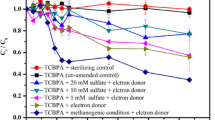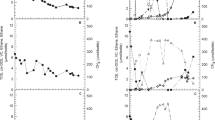Abstract
Reductive dechlorination is an advantageous process to microorganisms under anaerobic conditions because it is an electron sink, thereby allowing reoxidation of metabolic intermediates. In some organisms this has been demonstrated to support growth. Many chlorinated compounds have now been shown to be reductively dechlorinated under anaerobic conditions, including many of the congeners in commercial PCB mixtures. Anaerobic microbial communities in sediments dechlorinate Aroclor at rates of 3 µg Cl/g sediment × week. PCB dechlorination occurs at 12° C, a temperature relevant for remediation at temperate sites, and at concentrations of 100 to 1000 ppm. The positions dechlorinated are usually meta > para > ortho. The biphenyl rings, and the mono-ortho- and diorthochlorobiphenyls were not degraded after a one year incubation. Hence subsequent aerobic treatment may be necessary to meet regulatory standards. Reductive dechlorination of Arochlors does reduce their dioxin-like toxicity as measured by bioassay and by analysis of the co-planar congeners. The most important limitation to using PCB dechlorination as a remediation technology is the slower than desired dechlorination rates and no means yet discovered to substantially enhance these rates. Long term enrichments using PCBs as the only electron acceptor resulted in an initial enhancement in dechlorination rate. This rate was sustained but did not increase in serial transfers. Bioremediation of soil contaminated with Aroclor 1254 from a transformer spill was dechlorinated by greater than 50% following mixing of the soil with dechlorinating organisms and river sediment. It is now reasonable to field test reductive dechlorination of PCBs in cases where the PCB concentration is in the range where regulatory standards may be directly achieved by dechlorination, where a subsequent aerobic treatment is feasible, where any co-contaminants do not pose an inhibitory problem, and where anaerobic conditions can be established.
Similar content being viewed by others
References
Abramowicz DA (1990) Aerobic and anaerobic biodegradation of PCBs: A review. Crit. Rev. Biotech. 10: 241–251
Abramowicz DA, Brennan MJ & Dort HM van (1990) Anaerobic and aerobic biodegradation of endogenous PCBs. In: Research and Development Program for the Destruction of PCBs, Chapter 6, Ninth Progress Report (pp 55–69). General Electric Company, Corporate Research and Development
Bedard DL, Wagner RE, Brennan MJ, Haberl ML & Brown JF Jr (1987) Extensive degradation of Aroclors and environmentally transformed polychlorinated biphenyls byAlcaligenes eutrophus H850. Appl. Environ. Microbiol. 53: 1094–1102
Brown JF, Bedard DL, Brennan MJ, Carnahan JC, Feng H & Wagner RE (1987) Polychlorinated biphenyl dechlorination in aquatic sediments. Science 236: 709–712
Brown JF Jr, Wagner RE, Carnahan JC, Dorn SB, Chalek CL & Lawton RW (1988) Identification of PCB transformation processes occuring in nature. Chapter 8 in Research and Development Program for the Destruction of PCBs — Seventh Progress Report, GE Research and Development Center, Schenectady, NY
Dolfing J & Tiedje JM (1987) Growth yield increase linked to reductive dechlorination in a defined 3-chlorobenzoate degrading methanogenic co-culture. Arch. Microbiol. 149: 102–105
Dolfing J (1990) Reductive dechlorination of 3-chlorobenzoate is coupled to ATP production and growth in an anaerobic bacterium, strain DCB-1. Arch. Microbiol. 153: 264–266
Dort HM van & Bedard DL (1991) Reductiveortho andmeta dechlorination of a polychlorinated biphenyl congener by anaerobic microorganisms. Appl. Environ. Microbiol. 57: 1576–1578
Giesy J, Jones PP & Mora M. (1992) unpublished data.
Kuhn EP & Suflita JM (1989) Dehalogenation of pesticides by anaerobic microorganisms in soils and groundwater — a review. In: Sawhney & Brown (Eds) Reactions and Movements of Organic Chemicals in Soils (pp 111–180). Soil Sci. Soc. Am. and Am. Soc. Agron., Madison, WI
Mohn WW & Tiedje JM (1990) Strain DCB-1 conserves energy for growth from reductive dechlorination coupled to formate oxidation. Arch. Microbiol. 153: 267–271
—— (1991) Evidence for chemiosmotic coupling of reductive dechlorination of ATP synthesis inDesulfomonile tiedjei. Arch. Microbiol. 157: 1–6
—— (1992) Microbial reductive dehalogenation. Microbial Rev. 80: 482–507
Nies L & Vogel TM (1990) Effects of organic substrate on dechlorination of Aroclor 1242 in anaerobic sediments. Appl. Environ. Microbiol. 56: 2612–2617
Nies L, Anid PJ & Vogel TM (1990) Sequential anaerobic-aerobic biodegradation of PCBs. In: Research and Development Program for the Destruction of PCBs, Chapter 7, Ninth Progress Report (pp 71–80). General Electric Company, Corporate Research and Development
Quensen JF III, Tiedje JM & Boyd SA (1988) Reductive dechlorination of polychlorinated biphenyls by anaerobic microorganisms from sediments. Science 242: 752–754
Quensen JF III, Boyd SA & Tiedje JM (1990) Dechlorination of four commercial polychlorinated biphenyl mixtures (Aroclors) by anaerobic microorganisms from sediments. Appl. Environ. Microbiol. 56: 2360–2365
Quensen JF III, Tiedje JM, Boyd SA, Enke C, Lopshire R, Giesy J, Mora M, Crawford R, Tillitt D. (1992) Evaluation of the suitability of reduction dechlorination for the remediating PCB-contaminated soils and sediments. In: Soil Decontamination using Biological Processes DECHEMA, Frankfurt and Main, Germany
Tiedje JM, Quensen JF III, Mohn WW, Schimel JP, Cole JA & Boyd SA (1991) Reductive dechlorination of chlorinated aromatic pollutants. In: Rossmoore RW (Ed) Biodeterioration and Biodegradation 8 (pp 292–307). Elsevier Applied Science, New York, NY
Vogel TM, Criddle CS & McCarty PL (1987) Transformations of halogenated aliphatic compounds. Environ. Sci. Technol. 21: 722–736
Author information
Authors and Affiliations
Additional information
This paper was presented at the Pacific Basin Conference on Hazardous Waste, April, 1992, Bangkok, Thailand. Published by permission of the Pacific Basin Consortium for Hazardous Waste Research, East-West Center, Honolulu, HI
Rights and permissions
About this article
Cite this article
Tiedje, J.M., Quensen, J.F., Chee-Sanford, J. et al. Microbial reductive dechlorination of PCBs. Biodegradation 4, 231–240 (1993). https://doi.org/10.1007/BF00695971
Received:
Accepted:
Issue Date:
DOI: https://doi.org/10.1007/BF00695971




